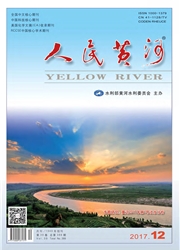

 中文摘要:
中文摘要:
为合理评价黄河下游河道健康状况,将可变模糊识别方法引入河道健康评价中,并以二元比较法确定指标权重,对黄河下游河道1986--2005年各河段的健康状况进行评价。结果表明:从河段来看,花园口一高村河段的河道健康状况优于其他河段;从时段来看,1986--1999年黄河下游河道健康状况整体呈现下滑趋势,而2000--2005年则处于逐步恢复时期。总的来说,黄河下游河道各河段从2003年开始基本恢复到亚健康水平,整体趋于好转之中。将评价结果与实际状况及经典模糊数学综合评价结果进行对比,表明可变模糊识别在河道健康评价中能准确反映河道健康状况。
 英文摘要:
英文摘要:
Abstract: In order to get rational fiver health assessment, the variable fuzzy recognition method was applied in assessing the health of each reach of the Lower Yellow River from 1986 to 2005. The index weight was detemfined by using binary comparison method. The results show that most of the time the river health of Huayuankou-Gaocun reach is better than others and the Lower Yellow River health status is in overall downward trend during 1986--1999, while during 2000--2005 is in a period of gradual recovery. In a word, the Lower Yellow River reaches have already returned to the sub-health level since 2003, tending to get better. Meanwhile, the evaluation results are verified with the actual condition and comparing with the results of classical fuzzy mathematics, it shows that the variable fuzzy recognition in fiver health assessment can accurately reflect the health status of the Lower Yellow River.
 同期刊论文项目
同期刊论文项目
 同项目期刊论文
同项目期刊论文
 Risk analysis of dynamic control of reservoir limited water level by considering flood forecast erro
Risk analysis of dynamic control of reservoir limited water level by considering flood forecast erro Inter-basin water transfer-supply model and risk analysis with consideration of rainfall forecast in
Inter-basin water transfer-supply model and risk analysis with consideration of rainfall forecast in 期刊信息
期刊信息
